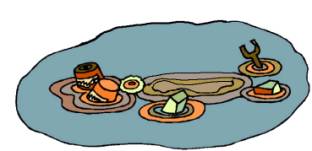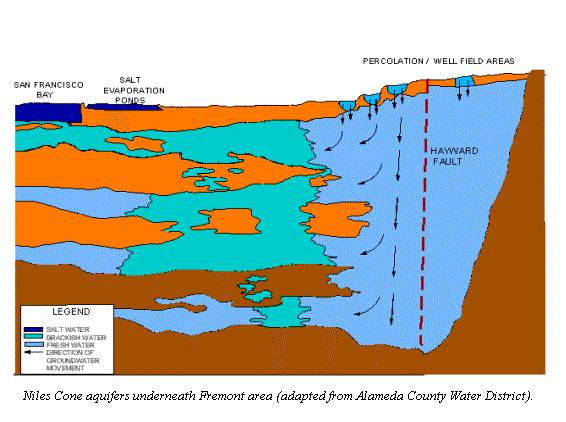 STORMWATER
AND WETLAND CHEMISTRY
STORMWATER
AND WETLAND CHEMISTRYLesson Plan
Tule Ponds at Tyson Lagoon
 STORMWATER
AND WETLAND CHEMISTRY
STORMWATER
AND WETLAND CHEMISTRY
Lesson Plan
Tule Ponds at Tyson Lagoon
pdf
OBJECTIVES:
1.
Students learn where drinkable water is from in the Fremont area.
2. Students learn about pollutants
that stormwater brings into Tule Ponds at Tyson Lagoon during a storm.
3. Students explore ways in which
stormwater is cleaned by organisms in wetlands.
4. Students sample pond water and
perform chemical tests.
VOCABULARY:
·
elements –
a substance cannot be reduced to simpler substances by normal chemical means
·
compounds
– made up of more than one element
·
heavy
metals - A metal with a specific gravity greater than about 5.0,
especially one that is poisonous, such as lead or mercury
·
hydrocarbons
- organic compounds that
contain only carbon and hydrogen.
·
pesticide
- a chemical used to kill
insects
·
respiration
- chemical energy of organic molecules is
released in a series of metabolic steps involving the consumption of oxygen and
the liberation of carbon dioxide and water
·
toxic
– harmful and/or poisonous
BACKGROUND:
 The
Tule Ponds at Tyson Lagoon provides a unique opportunity to see how the needs of
humans in an urban setting and other organisms can mutually co-exist.
Before humans arrived in what is now Fremont, many organisms like
mammals, birds, insects, and fish inhabited the area.
As areas become urbanized (populated with people and their buildings) the
natural order of things starts to change.
The
Tule Ponds at Tyson Lagoon provides a unique opportunity to see how the needs of
humans in an urban setting and other organisms can mutually co-exist.
Before humans arrived in what is now Fremont, many organisms like
mammals, birds, insects, and fish inhabited the area.
As areas become urbanized (populated with people and their buildings) the
natural order of things starts to change.
Prior
to urbanization, water from rain soaked into the ground and slowly percolated
into the layers of the soil and bedrock.
If there were more rain than the earth could handle, the water would
“run off” causing floods. These
flood waters brought nutrients from the nearby hills, and the plants,
especially, benefited. As
people built homes and laid down asphalt and cement for cars to use, water
flowed more quickly. They usually
build homes in the flat area near a river, which is referred to as a flood
plain. The rains caused flooding and damage to many homes.
To prevent floods, engineers developed ways to allow the water to flow
quickly through man-made channels that would bring water to the San Francisco
Bay edge. It works, but it also
causes loss of valuable habitat for other creatures.
The
Tule Ponds at Tyson Lagoon acts as a flood area to slow down and contain water
on its way out to the bay. After
water leaves the lagoon it flows through earth or concrete-lined channels out to
the bay. This area helps to prevent
floods, but also acts as a natural place for organisms to thrive. Water in this area is also from underground water that
percolates up via the Hayward Fault.
 These
wetlands also help to remove substances that enter the system from residential,
urban, and agricultural runoff. Some
of these substances are considered pollutants and may be toxic to different
types of organisms. Residential and urban runoff in this area would include
garbage, pesticides, oil and grease, organic matter, and heavy metals.
Agricultural runoff from nearby small farms would include pesticides and
nutrients. The frequency of these
substances is intermittent and dependent on winter rains.
These
wetlands also help to remove substances that enter the system from residential,
urban, and agricultural runoff. Some
of these substances are considered pollutants and may be toxic to different
types of organisms. Residential and urban runoff in this area would include
garbage, pesticides, oil and grease, organic matter, and heavy metals.
Agricultural runoff from nearby small farms would include pesticides and
nutrients. The frequency of these
substances is intermittent and dependent on winter rains.
During
a storm event, water will run off from asphalt, cement, and saturated soil
carrying with it sediments, chemicals, and trash. Ponds B and C have logs
anchored at the surface to help retard the flow of objects that float, like oil
and garbage. Motor oil coats fish gills, preventing
the
fish’s ability to use dissolved oxygen contained in the water.
Oil can coat bird wings, making flight difficult and prevents feathers
from “fluffing up” to provide insulation against the cold.
You can notice that the constrictions between the ponds help
to narrow the flow and trap these lighter objects. The removal of harmful objects protects the wildlife.
Concentrations of
sediments, chemicals, and garbage change during a storm event.
The early part of a storm transports the largest amount of larger
particles whereas the later stages of storms have a higher percentage of
dissolved hydrocarbons and dissolved metals.
The velocity of the water also slows as stormwater enters the Tule Pond
system. This allows heavy particles
to drop out of the system first.
TABLE 1 Categories of Principal Contaminants in Stormwater |
|
|
Category |
Examples |
|
Metals |
zinc,
cadmium, copper, chromium, arsenic, lead |
|
Organic
chemicals |
pesticides,
oil, gasoline, grease |
|
Pathogens |
viruses,
bacteria, protozoa |
|
Nutrients |
nitrogen,
phosphorus |
|
Biochemical
oxygen demand (BOD) |
grass
clippings, fallen leaves, hydrocarbons, human, and animal waste |
|
Sediment |
sand,
soil, and silt |
|
Salts |
sodium
chloride, calcium chloride |
Pond A is
designed to slow the flow of water to allow suspended particles to drop out of
the water column. This increases the quality of the water so it is less of
a potential hazard when it enters the San Francisco Bay. The suspended
particles range from heavy metals, such as copper (Cu), lead (Pb) and zinc (Zn),
to simple particles like sediment and soil.
The particles increase turbidity and prevent the penetration of sunlight
to phytoplankton. Increased
nutrients in the water caused by fertilizers (such as nitrogen (N), phosphorus
(P), and Potassium (K) create algal “blooms.”
As the plants decompose they cause conditions unfriendly to organisms in
the water (eutrophication). Lead comes from paints, wood staining products, and
emissions from diesel and gasoline operated vehicles.
Zinc is from automobile tires, paints, and wood staining products. Copper comes from plumbing, electroplating processing
wasters, brake pads in automobiles, and algaecides.
In high dosages these substances can be hazardous to organisms that live
or frequent the ponds
Water quality is
frequently enhanced as water passes through wetland. Plants help to slow the flow of surface run off and cause
sediment to settle out. Living
aquatic plants like algae and large emergent plants like tules and cattails, add
dissolved oxygen to water during photosynthesis. Wetland plants support much of the life in open water,
and plants like cattails and tules provide shelter for larger animals living in
the pond.
PROCEDURE:
1.
Show students Periodic Table of the Elements placemat and review elements
and compounds. Define a heavy
metal.
2.
Define a watershed by having students circle the local watersheds in the
Fremont area.
3.
Discuss information in the background.
Instruct students to read the graph of “Heavy Metals from
Transportation.” Answer the
questions in the booklet.
4.
Before you go on a walk have the students do the following chemical
experiment.
Add
1-2 drops of bromothymol blue to 15mL of water in a 25 ml graduated cylinder.
Gently blow into the tube using a straw until it changes color to yellow. Have
the students discuss the change. [The change occurs because CO2 , has
been added to the solution, making it more acidic therefore causing a color
change. Remember, humans produce carbon dioxide and utilize oxygen whereas
plants utilize carbon dioxide and produce oxygen]
Place a piece of elodea or “green water” from Tule
in the 25mL graduated cylinder with the yellow solution and insert a cork
stopper in the beak of the cylinder. Expose the cylinder to sunlight for 20
minutes. [The yellow solution will change back to blue because the plant will
utilize the carbon dioxide, making the solution less acidic, converting the
color back to blue. ]
5. Go on a walk of the facility and
then when you return discuss what chemical reaction has taken place. Write the
following reaction on the board:
[carbon dioxide +
water - yields - carbohydrate + oxygen + water]
Explain the exchange of gases and how
humans and plants live together in a mutual relationship. Without plants humans
would not have oxygen and without humans plants would have no carbon dioxide.
Through photosynthesis, plants produce food for both themselves and other living
organisms. Remind students that when animals eat plants they too are eating the
food that the plants produced.
FOR MORE LESSONS:
http://msnucleus.org/membership/html/k-6/wc/water/5/wcwa5_3a.html
http://msnucleus.org/membership/html/k-6/lc/plants/5/lcp5_3a.html